Repairing Puerto Rico’s Corals
Air Date: Week of June 28, 2019
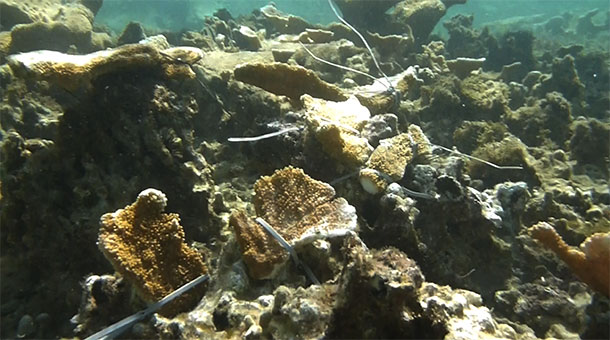
Grupo Vidas workers have used zip ties to reattach hundreds of coral fragments to the reef near Vega Baja. (Photo: Ricardo Loreano)
Roughly 10 percent of Puerto Rico’s corals were broken and damaged by Hurricane Maria in 2017. But, as Host Bobby Bascomb reports, marine conservationists are finding ways to give corals a fighting chance by reattaching healthy fragments.
Transcript
BASCOMB: Given the right environmental conditions, corals can be surprisingly easy to propagate and re-attach to an existing reef. When Hurricane Maria pummeled Puerto Rico in 2017, roughly 10 percent of the island’s corals were damaged; large chunks were broken off by rough seas and ocean swells. But in this story that first aired shortly after the hurricane, I found there’s still hope for thousands of battered bits of coral lying around the sea floor.
[WAVE SOUNDS]
BASCOMB: I’m standing on a tall dune near Vega Baja on Puerto Rico’s north coast. The ocean stretches out in shades of dark blue, turquoise, and pale aquamarine.
But interspersed among the usual colors of a tropical ocean are patches of brownish orange – elkhorn coral. Salvador Loreano is a worker with the environmental NGO Grupo V.I.D.A.S. Their main task is coral restoration.
S. LOREANO: Our goal right now is to plant coral fragments here because you know that Maria, Hurricane Maria, came here and devastated the island. This caused great damage to the coral reef because the first time we went to there after Maria, the reef was like destroyed, like we’d see big coral colonies upside down and a lot of dead coral.
BASCOMB: As long as they remain submerged under water, these coral, which are colonies of tiny invertebrate animals, have a 20 percent chance of survival. But that increases to more than 90 percent if they are attached to a larger structure, not getting banged around by the surf or smothered with sand.
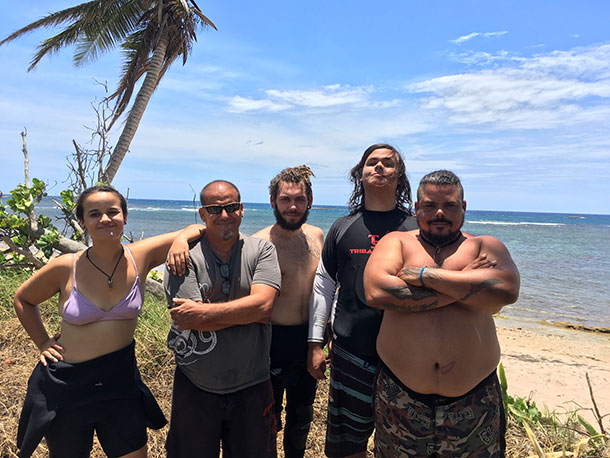
The Grupo Vidas crew taking a break from their coral restoration work. (Photo: Bobby Bascomb)
If a piece of coral is at least 2 inches long and 80 percent healthy, it can actually be reattached to an existing reef. Salvador points towards the water…
S. LOREANO: Over there is my sister and that’s one of my friends that work here. They’re preparing to enter to the Arrecife El Eco.
BASCOMB: Can we go see what they’re doing?
S. LOREANO: Yes.
[WALKING SOUNDS]
BASCOMB: Mariola Loreano is standing on the shore in about a foot of water.
S. LOREANO: Mariola!
BASCOMB: She’s wearing a rash guard to protect from the hot tropical sun.
A mask is perched on her forehead, a snorkel dangling off it. She’s holding a white milk crate with all the tools the crew will need for their morning’s work.
M. LOREANO: Yeah, basically what we have in there is a sledge hammer; a slate where we write our tallies, basically, which is all of the fragments that we’ve successfully planted; a bag for any trash that we find inside the ocean; a buoy so it floats.
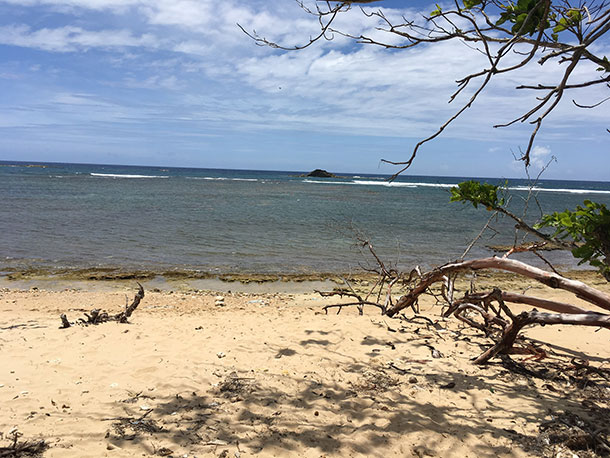
The beach near Vega Baja, Puerto Rico. (Photo: Bobby Bascomb)
BASCOMB: So, should I put on my fins then and we head in?
S. LOREANO: if you’re using flippers, I recommend that you either walk sideways or back because, you know, if you use flippers walking front, it’s going to be rather difficult.
BASCOMB: I’m going to fall on my face.
S. LOREANO: Most… mostly. [LAUGHS] I can help you enter the reef, because, well, it’s all rocky, but there are a lot of sea urchins there.
BASCOMB: Oh, so it’s spiny.
S. LOREANO: Yeah, but it’s not that big of a deal because they’re really deep inside the crevices so they won’t sting you.
BASCOMB: So, is there any other advice I need before we go in?
S. LOREANO: One thing you got to be careful of, it’s not that big of an issue, but scorpion fish have also appeared here. You know how they camouflage very well?
BASCOMB: I don’t actually.
S. LOREANO: They rely on their camouflage. And sometimes their camouflage is really good. [LAUGHS] So it’s best to keep an eye out where you put your hand and everything.
BASCOMB: I’m not going to touch anything.
S. LOREANO: I know, I know! – just in case.
[SOUNDS OF WATER SPLASHING]
BASCOMB: We put on our mask, snorkel, and fins and walk backwards into the bath-warm water, stepping over the sharp black sea urchins.
[SPLASHING SOUNDS]
BASCOMB: Once the water is knee-deep, we splash in and swim about 500 feet to the reef.
[UNDERWATER BREATHING SOUNDS]
BASCOMB: A rainbow of fish greets us – green fish with florescent blue heads, black fish with yellow stripes, green fish with pink stripes. They’re all juvenile fish, and the reef is a critical habitat for them. Bulbous brain coral dot the sea floor, and orange elkhorn coral stick out at awkward angles, much like its namesake.
[SCRAPING SOUND]
BASCOMB: A worker named Ernesto is already hard at work.
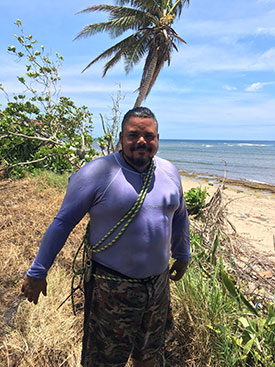
Ernesto Vélez Gandía stands on the beach getting ready to reattach bits of coral broken off the reef by Hurricane Maria. (Photo: Bobby Bascomb)
He uses a wire brush to scrape algae off a piece of coral the size of a ping pong paddle and does the same to a suitable spot on the reef. Just like gluing two objects together, you need to start with a clean surface on both sides. Then he pulls a plastic zip tie out of his sleeve and uses it to attach the coral in place.
He uses pliers with a florescent pink handle to pull the zip tie tight and cut off the excess plastic, which he sticks into his other sleeve. This piece of coral is now one of hundreds just like it pinned to the reef with zip ties. And in two to three weeks, it will grow onto the reef enough to stay put on its own.
[WAVE SOUNDS]
BASCOMB: Roughly 15 percent of the coral here at Vega Baja was broken off by hurricane Maria. But these corals evolved with hurricanes. If hurricane damage was the only issue, this work wouldn’t be necessary. But much like the world’s coral reefs in general, this reef has a lot of challenges.
Grupo V.I.D.A.S. worker Ernesto says one of the biggest problems is algae blooms from sewage runoff. In many places the coral is essentially smothered, leaving it a ghostly gray color.
VÉLEZ GANDÍA: Yeah, those… they look like zombies, right there.
BASCOMB: They look like zombies, like Day of the Dead.
VÉLEZ GANDÍA: Yeah, it’s like Day of the Dead but under the water.
BASCOMB: There is a very large dead coral at the entrance to the reef in the shallowest, warmest water. Ernesto believes that one died not from algae blooms but from stress of a warming ocean.
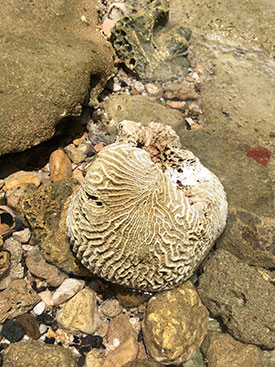
A piece of dead brain coral washed up on the beach.(Photo: Bobby Bascomb)
VÉLEZ GANDÍA: The water is getting warmer. Every year it’s getting warmer.
BASCOMB: Standing on the dune in a light blue rash guard and smoking a cigarette, Ernesto talks about the death of that coral as one might talk about a member of the family passing away.
VÉLEZ GANDÍA: And we got a lot of love for him. We saw him alive, very alive. He is one of the oldest in our reef. But he start dying, we saw the process of his death. So, we just admire him and remember him. It’s very sentimental, I don’t know, but it’s deep in the heart.
BASCOMB: Adding to the warming water and algae blooms, ship groundings break off large chunks of coral each year; collectors intentionally break it off to sell for home aquariums; and spear fishermen damage it with their equipment.
Ocean acidification and coral bleaching are also huge problems for the world’s corals, and Puerto Rico is no exception. The team admits it’s an uphill battle to save this reef, but Salvador says they’re already seeing results.
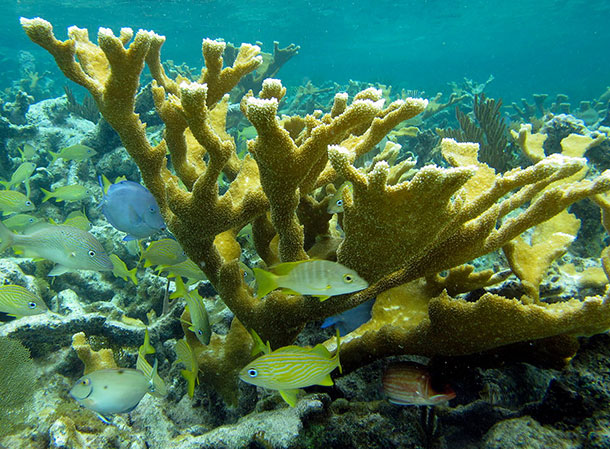
Elk horn coral are part of a vital reef ecosystem that provide habitat for fish. (Photo: Sean Nash, Flickr, CC BY-NC-SA 2.0)
S. LOREANO: Our work has given us results like species that we thought we’d never see again started to return, like moray eels, scorpion fish, sea cucumbers, puffer fish, sand dollars, which are a species of flat sea urchin, and also there’s like a spotted eagle ray hanging around over there.
BASCOMB: Projects like this have actually been going on for nearly 20 years on a small scale. But one million dollars of post-Maria funding allowed scientists from NOAA, the National Fish and Wildlife Foundation, and independent NGOs to speed up their efforts. Workers have been able reattach roughly 15,000 pieces of coral to the reefs surrounding Puerto Rico.
Links
Living on Earth wants to hear from you!
Living on Earth
62 Calef Highway, Suite 212
Lee, NH 03861
Telephone: 617-287-4121
E-mail: comments@loe.org
Newsletter [Click here]
Donate to Living on Earth!
Living on Earth is an independent media program and relies entirely on contributions from listeners and institutions supporting public service. Please donate now to preserve an independent environmental voice.
NewsletterLiving on Earth offers a weekly delivery of the show's rundown to your mailbox. Sign up for our newsletter today!
 Sailors For The Sea: Be the change you want to sea.
Sailors For The Sea: Be the change you want to sea.
 The Grantham Foundation for the Protection of the Environment: Committed to protecting and improving the health of the global environment.
The Grantham Foundation for the Protection of the Environment: Committed to protecting and improving the health of the global environment.
 Contribute to Living on Earth and receive, as our gift to you, an archival print of one of Mark Seth Lender's extraordinary wildlife photographs. Follow the link to see Mark's current collection of photographs.
Contribute to Living on Earth and receive, as our gift to you, an archival print of one of Mark Seth Lender's extraordinary wildlife photographs. Follow the link to see Mark's current collection of photographs.
 Buy a signed copy of Mark Seth Lender's book Smeagull the Seagull & support Living on Earth
Buy a signed copy of Mark Seth Lender's book Smeagull the Seagull & support Living on Earth

